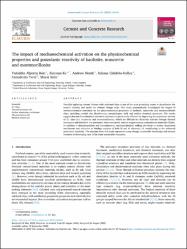The impact of mechanochemical activation on the physicochemical properties and pozzolanic reactivity of kaolinite, muscovite and montmorillonite

View/
Access
info:eu-repo/semantics/openAccessDate
2022Author
Baki, Vahiddin AlperenKe, Xinyuan
Heath, Andrew
Calabria-Holley, Juliana
Terzi, Cemalettin
Şirin, Murat
Metadata
Show full item recordCitation
Baki, V.A., Ke, X.Y., Heath, A ., Calabria-Holley, J., Terzi, C. & Sirin, m. (2022). The impact of mechanochemical activation on the physicochemical properties and pozzolanic reactivity of kaolinite, muscovite and montmorillonite. Cement and Concrete Research, 162, 106962. https://doi.org/10.1016/j.cemconres.2022.106962Abstract
Partially replacing cement clinkers with activated clays is one of the most promising routes to decarbonise the cement industry and tackle the climate change crisis. This study systematically investigated the impact of mechanochemical activation on the physicochemical properties of kaolinite, muscovite and montmorillonite clays, including particle size distributions, morphologies, bulk and surface chemical structures. The results suggest that mechanochemical activation treatment is particularly efficient for improving the pozzolanic activity of 2:1 clays (i.e. muscovite and montmorillonite), which are difficult to effectively activate through thermal treatments and therefore not previously been extensively used as supplementary cementitious materials (SCMs). In addition to dehydroxylation and amorphisation, mechanochemical milling also leads to surface aluminium enrichment and reduction in binding energies of both Si and Al elements, all contributing to the enhanced pozzolanic reactivity. The outcome from this study represents a step-change in scientific knowledge and extends frontiers of developing new SCMs from sustainable resources.

















